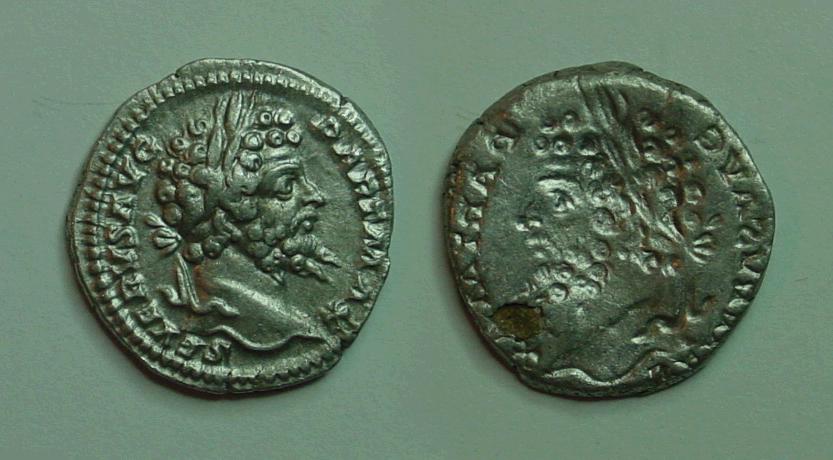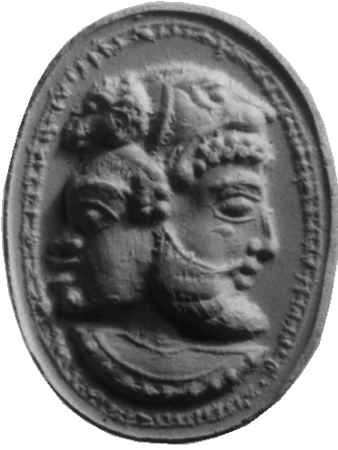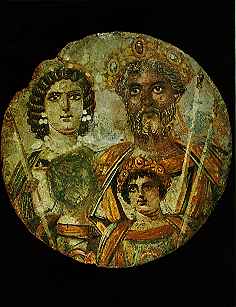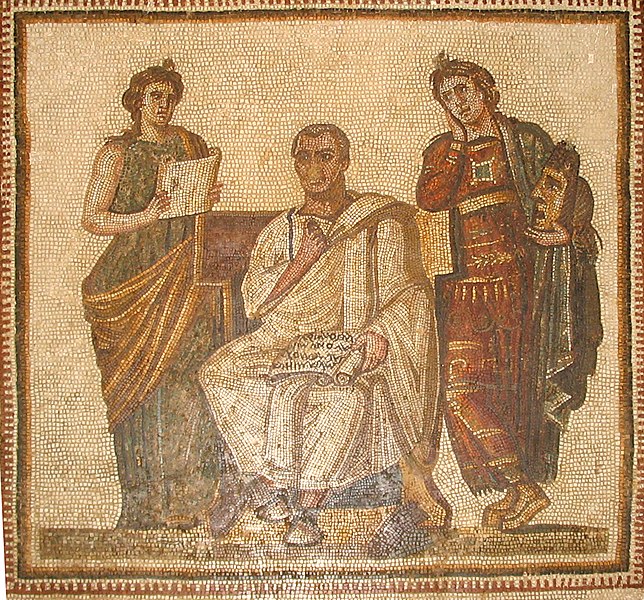|
|
Post by blackuhuru420 on Mar 4, 2012 21:44:01 GMT -5
Nice thread Brada.. When it comes to Severus, its no Afrocentrics who are claiming this man as Rome's first black Emperor, Anyone who studies him in depth knows this man was seen as "Dark Skinned" despite his Italian Blood.  -from Caesars' Wives : Sex, Power, and Politics in the Roman Empire (Read the last line and weep..) ^^^ This is a non Afrocentric, Im assuming white European who is claiming that Severus was Rome's first black emperor. Ive also read in many other sources that Severus was constantly called Dark Skinned and was remembered as a Dark skinned man. Now you have Euroclowns and Berber Radicals trying to use some unpainted bust as proof that Severus was non black..         Seeing these bearded sculptures reminds of bearded rastas ![]() www.beforebc.de/all_europe/700_mediterranean/02-16-700-02.jpg www.beforebc.de/all_europe/700_mediterranean/02-16-700-02.jpg [/img]   |
|
|
|
Post by anansi on Mar 7, 2012 5:17:28 GMT -5
Before Rome had the leadership of many Africans fighting and protecting the Roman way,I would be re-missed if I did not include those who fought Rome on Roman soil to the bitter end. None other came to mind as Hannibal of Kart-Hadast scourge of Rome.general knowladge. He is generally considered one of the greatest military commanders in history. His father, Hamilcar Barca, was the leading Carthaginian commander during the First Punic War, his younger brothers were Mago and Hasdrubal, and he was brother-in-law to Hasdrubal the Fair. Hannibal lived during a period of great tension in the Mediterranean, when the Roman Republic established its supremacy over other great powers such as Carthage, the Hellenistic kingdoms of Macedon, Syracuse, and the Seleucid empire. One of his most famous achievements was at the outbreak of the Second Punic War, when he marched an army, which included war elephants, from Iberia over the Pyrenees and the Alps into northern Italy. In his first few years in Italy, he won three dramatic victories — Trebia, Trasimene, and Cannae — and won over many allies of Rome. Hannibal occupied much of Italy for 15 years, but a Roman counter-invasion of North Africa forced him to return to Carthage, where he was decisively defeated by Scipio Africanus at the Battle of Zama. Scipio had studied Hannibal's tactics and brilliantly devised some of his own, and finally defeated Rome's nemesis at Zama, having previously driven Hasdrubal, Hannibal's brother, out of the Iberian Peninsula. After the war, Hannibal successfully ran for the office of suffete. He enacted political and financial reforms to enable the payment of the war indemnity imposed by Rome. However, Hannibal's reforms were unpopular with members of the Carthaginian aristocracy and in Rome, and he fled into voluntary exile. During this time, he lived at the Seleucid court, where he acted as military adviser to Antiochus III in his war against Rome. After Antiochus met defeat at Magnesia and was forced to accept Rome's terms, Hannibal fled again, making a stop in Armenia. His flight ended in the court of Bithynia, where he achieved an outstanding naval victory against a fleet from Pergamon. He was afterwards betrayed to the Romans and committed suicide by poisoning himself. en.wikipedia.org/wiki/HannibalControversy on what he may have looked liked there are many images of him flouting around the internet the most common are these  A marble bust, reputedly of Hannibal, originally found at the ancient city-state of Capua in Italy (some historians are uncertain of the authenticity of the portrait) A marble bust, reputedly of Hannibal, originally found at the ancient city-state of Capua in Italy (some historians are uncertain of the authenticity of the portrait)  Then there are coins like these reported to be in the British Museum Obviously they all can't be of the same person and the Carthaginians themselves are no help as they are phenotypically diverse even with in the same family Then there are coins like these reported to be in the British Museum Obviously they all can't be of the same person and the Carthaginians themselves are no help as they are phenotypically diverse even with in the same family But however he might have looked he took a very large amount of Africans with him into Roman dominated Europe,that dominated the scene for fourteen yrs But however he might have looked he took a very large amount of Africans with him into Roman dominated Europe,that dominated the scene for fourteen yrs |
|
|
|
Post by anansi on Apr 2, 2012 11:50:35 GMT -5
  More Africans from the Dacian Wars, I was searching for this image for awhile it showed a high ranking African soldier of Rome,this is a passage from Ivan Van Sertima's book Golden age of The Moor. "The wars of Jugurtha," writes Graham Webster, demonstrated the value of the nimble Moorish horsemen who Trajan later found so useful against the Dacians. During the Dacian Wars of Eastern Europe (101-105), the Roman military relied heavily upon highly mobile units of Moorish cavalry. On a Roman coloumn dedicated to the wars of Trajan in Dacia, there is a special relief devoted to a large body of galloping horsemen easily recognizable as Moors. They are depicted with tiered and plaited rows of curled hair, short tunics, and saddle-less with only a single bridle. Another work dated to the same period is terracotta human head found in the Dacian city of Suicidava. Described by archeologists as the head of a "Negro or Moor," it is in many respects similar to the horse cavalry depicted on the Roman column. Black soldiers, specifically identified as Moors, were actively recruited by Rome and served tours of duty in Britain, France, Switzerland, Austria, Poland, Romania, etc. An original brass military diploma which dates from the middle of the second century A.D. mentions Moorish soldiers in Moesia, which is modern Serbia. Another military diploma of A.D. speaks of Moorish soldiers from Africa in Dacia, or modern Romania, and also of auxiliary troops of the Dacian Moors. A Roman document, Notitia Dignitatum dates from the beginning of the fifth century A.D., mentions several Moorish battalions in the Balkans and the Moorish military colony Ad Mauros was located on the Inn River near Vienna; and in what modern Besarabia, there is was a city called Maurocastrum. According to the document Notitia Dignitatum, 2500to 5000 illyrian Moorish soldiers, in five separate military units, had served in the Near East. From this document we must deduce that at the beginning of the fifth century at least 100,000 descendants of Moors lived in Illyricum, which was located in the present-day Balkans. Regarding specific military men of Moorish extraction, there were several Rome honourably, or had ancestors that participated in Rome’s foreign wars. In 253 A.D., for example, "After his departure, the governor of Lower Moesia (modern Serbia), M. Aemilius Aemilianus, a Moor born Mauritania, in defeating the Goths and was proclaimed emperor by his troops. In another case, Zenophilus, Consul of Numidia, boasts that my grandfather is a soldier; he had served in the Commitatus, for our family is of Moorish origin. To the Commitatus belonged the renowned Equites Mauri, a Black horse cavalry of North Africa. For example, the city of Osuna, in southern Spain, has yielded several archaeological works depicting Blacks with tightly curled hair which archaeologists have labeled "Negroid." As long ago as 170 A.D., writes Durant, "the Mauri Moors invaded Spain from Africa." Even earlier, according to Laroui, "The Berbers of that region [North Africa] made incursions into Baetica, Spain. But the use of the term "Berber" perhaps camouflages the issue here. RegardÂing the same event, W.T. Arnold' speaks of "Moorish incursions in Baetica as early as the first century. Interestingly enough, many of these Moors were Christians. During the sixth century, the Byzantine historian Procopius and the Latin poet Corippus compiled precious documents regarding the Moors in post Roman North Africa. www.nok-benin.co.uk/prev-articles/royal_2.htm |
|
|
|
Post by herodotus on Oct 21, 2013 21:40:26 GMT -5
You couldn't be more wrong about Severus. Snowden (1970) cites an ancient source, the Historia Augusta, showing that Severus was troubled by dark skin, so much so, he wanted a dark skinned African removed from his sight: "22. On another occasion, when he was returning to his nearest quarters from an inspection of the wall at Luguvallum in Britain, at a time when he had not only proved victorious but had concluded a perpetual peace, just as he was wondering what omen would present itself, an Ethiopian soldier, who was famous among buffoons and always a notable jester, met him with a garland of cypress-boughs. And when Severus in a rage ordered that the man be removed from his sight, troubled as he was by the man's ominous colour and the ominous nature of the garland, the Ethiopian by way of jest cried, it is said, "You have been all things, you have conquered all things, now, O conqueror, be a god." penelope.uchicago.edu/Thayer/E/Roman/Texts/Historia_Augusta/Septimius_Severus*.html#ref165 |
|
|
|
Post by truthteacher2007 on Oct 21, 2013 22:04:59 GMT -5
You couldn't be more wrong about Severus. Snowden (1970) cites an ancient source, the Historia Augusta, showing that Severus was troubled by dark skin, so much so, he wanted a dark skinned African removed from his sight: "22. On another occasion, when he was returning to his nearest quarters from an inspection of the wall at Luguvallum in Britain, at a time when he had not only proved victorious but had concluded a perpetual peace, just as he was wondering what omen would present itself, an Ethiopian soldier, who was famous among buffoons and always a notable jester, met him with a garland of cypress-boughs. And when Severus in a rage ordered that the man be removed from his sight, troubled as he was by the man's ominous colour and the ominous nature of the garland, the Ethiopian by way of jest cried, it is said, "You have been all things, you have conquered all things, now, O conqueror, be a god." penelope.uchicago.edu/Thayer/E/Roman/Texts/Historia_Augusta/Septimius_Severus*.html#ref165Perfect proof that Africans were present in Roman era Britain. Thanks for your contribution!  |
|
|
|
Post by anansi on Oct 21, 2013 22:57:14 GMT -5
You couldn't be more wrong about Severus. Snowden (1970) cites an ancient source, the Historia Augusta, showing that Severus was troubled by dark skin, so much so, he wanted a dark skinned African removed from his sight: "22. On another occasion, when he was returning to his nearest quarters from an inspection of the wall at Luguvallum in Britain, at a time when he had not only proved victorious but had concluded a perpetual peace, just as he was wondering what omen would present itself, an Ethiopian soldier, who was famous among buffoons and always a notable jester, met him with a garland of cypress-boughs. And when Severus in a rage ordered that the man be removed from his sight, troubled as he was by the man's ominous colour and the ominous nature of the garland, the Ethiopian by way of jest cried, it is said, "You have been all things, you have conquered all things, now, O conqueror, be a god." penelope.uchicago.edu/Thayer/E/Roman/Texts/Historia_Augusta/Septimius_Severus*.html#ref165 Couple of things here him not being very dark skinned is not an issue he by his family portrait he was a red or high yella fella,in any case he seemed to be in fear of his demise and being very superstitious feared things black,like many today who have this irrational fear a black cat crossing their path before them this was common in the Roman world plus the ominous nature of the garland nailed it. He himself did stationed many Africans in Britain so did he feared the men whom he served with. |
|
|
|
Post by truthteacher2007 on Oct 23, 2013 13:10:47 GMT -5
You couldn't be more wrong about Severus. Snowden (1970) cites an ancient source, the Historia Augusta, showing that Severus was troubled by dark skin, so much so, he wanted a dark skinned African removed from his sight: "22. On another occasion, when he was returning to his nearest quarters from an inspection of the wall at Luguvallum in Britain, at a time when he had not only proved victorious but had concluded a perpetual peace, just as he was wondering what omen would present itself, an Ethiopian soldier, who was famous among buffoons and always a notable jester, met him with a garland of cypress-boughs. And when Severus in a rage ordered that the man be removed from his sight, troubled as he was by the man's ominous colour and the ominous nature of the garland, the Ethiopian by way of jest cried, it is said, "You have been all things, you have conquered all things, now, O conqueror, be a god." penelope.uchicago.edu/Thayer/E/Roman/Texts/Historia_Augusta/Septimius_Severus*.html#ref165 Couple of things here him not being very dark skinned is not an issue he by his family portrait he was a red or high yella fella,in any case he seemed to be in fear of his demise and being very superstitious feared things black,like many today who have this irrational fear a black cat crossing their path before them this was common in the Roman world plus the ominous nature of the garland nailed it. He himself did stationed many Africans in Britain so did he feared the men whom he served with. This quote proves nothing. We all know far too well from experiences the reality of colorism amongst people of color. Just look at India and their obsession with fair skin and color prejudice for example. |
|
|
|
Post by justcallmejari on Oct 24, 2013 10:48:51 GMT -5
You couldn't be more wrong about Severus. Snowden (1970) cites an ancient source, the Historia Augusta, showing that Severus was troubled by dark skin, so much so, he wanted a dark skinned African removed from his sight: "22. On another occasion, when he was returning to his nearest quarters from an inspection of the wall at Luguvallum in Britain, at a time when he had not only proved victorious but had concluded a perpetual peace, just as he was wondering what omen would present itself, an Ethiopian soldier, who was famous among buffoons and always a notable jester, met him with a garland of cypress-boughs. And when Severus in a rage ordered that the man be removed from his sight, troubled as he was by the man's ominous colour and the ominous nature of the garland, the Ethiopian by way of jest cried, it is said, "You have been all things, you have conquered all things, now, O conqueror, be a god." penelope.uchicago.edu/Thayer/E/Roman/Texts/Historia_Augusta/Septimius_Severus*.html#ref165The thing with Novices such as yourself is that you dont really know what you are talking about because you have not studied in depth as I have. This is what "Ethiopian" meant or implied in Classical Times..  Septimius Severus' portrait..     |
|
|
|
Post by Tukuler al~Takruri on Oct 24, 2013 12:14:31 GMT -5
Septimius Severus' portrait..   Thanks for reposting this solo image of Septimius Severus from his tondo found in Egypt and now in Berlin's Altes Museum.  I've no idea where that other one posted earlier came from and doubt its authenticity. Anyone know its provenance?  _____ vs _____  Until last year I never saw this one only the other which appears in many reference materials about Severus. Severus was a very Romanized North Africa who iirc claimed Punic ethnicity. He was ashamed of his own sister who spoke broken Latin and even Severus' Latin usage was tinged with a heavy Punic accent, which I find strange if his mother indeed was an Italian Roman native Latin speaker. I think Severus was more disturbed by the soldier's garland and jive assing and the Roman author who documents the event was expressing the general Roman attitude about black skin being an ill omen. Then, being thoroughly Romanized, it's possible Severus may've felt that way. Looking at Sudan and Mauritania among south Sahara/Sahel locales we see caramel and even milk chocolate brown skins holding prejudice toward milk and dark chocolate brown skins who don't have hair and/or facial features more characteristic of Africans of northern latitudes. Anyway, "now be a god" is a death wish. An emperor's promotion to deity would be made after his death, no? Not long after the event Severus became ill due to the northern climates and soon died.  |
|
|
|
Post by herodotus on Oct 24, 2013 20:36:27 GMT -5
"This is what "Ethiopian" meant or implied in Classical Times" This isn't true, the ancient Greek Aethiops were not only Negroid in physiognomy, but included other African variations. This is discussed by Snowden: "Frequent references to color indicate that the word Ethiopian designated persons of varying degrees of blackness. Furthermore, the association of various combinations of other physical characteristics with the Ethiopian suggests that the Greeks and Romans were describing at least two types of people." (Snowden, 1970) The first variation, Snowden describes as Negroid i.e broad in nose, and woolly haired, as your picture shows. No one denies this, however Aethiops were never limited to this single phenotype. Claiming so, is basically reviving Seligman's obsolete "true Negro" model. Snowden in his work discusses several other variations that existed among the Aethiops, including a range of facial features. Later Keita (1993) showed that lighter brown skin shades were not alien among the Aethiops - a term which included Saharan peoples. Keita, S.O.Y. (1993) “Black Athena: 'Race,' Bernal, and Snowdon.” Arethusa, 26. 295-314 Keita, S.O.Y., (1993) “Response to Bernal and Snowden.” Arethusa, 26. 329-34. www.jiscjournalarchives.ac.uk/browse/proquest/q434_issues/26_1993.htmlThe point here is that Aethiops in its ancient usage never referred to a single African phenotype, but a broad range, including lighter brown skinned Africans. Aethiops from αἴθω (aithō, “burn”) + ὤψ (ōps, “face”) means: burnt face (dark skinned). However there were varying shades of this "dark" pigmentation the ancient Greeks and Romans observed among Africans. Severus was not black, and the Historia Augusta contrasts him to Aethiops which includes light brown skin shades, so he was white skinned. |
|
|
|
Post by herodotus on Oct 24, 2013 20:54:00 GMT -5
Lloyd A. Thompson in his work "Romans and Blacks" (1989) points out that Aethiops in classical antiquity, also included Saharans:
"[Aethiopes] is a broad term conventionally applied to all peoples of the various ill-known or unknown parts of sub-Egyptian, Saharan, and sub-Saharan Africa which were all collectively called 'Aethiopia' ('In the world of sun-darkened people')."
Obviously it did not include all Saharans, but the fact it included some, discredits the "Aethiops" = "true Negro" equation (darkest skinned, woolly haired). In actual fact the Romans and Greeks were aware of lighter brown skinned Africans among the Aethiops with different facial features.
|
|
|
|
Post by azrur on Oct 24, 2013 21:23:34 GMT -5
 Publius Vergilius Maro Publius Vergilius MaroThe author of the Aeneid about the refugees from Troy that fathered the Romans. virgil is from africa? |
|
|
|
Post by azrur on Oct 24, 2013 21:25:40 GMT -5
But however he might have looked he took a very large amount of Africans with him into Roman dominated Europe,that dominated the scene for fourteen yrs i thought carthage military would be mostly mercenaries, he would bring numidians a few carthage levy and african elephants but after one of the earlier wars carthage stop using citizen soldiers because of their decimation in their last stand against the syracuse |
|
|
|
Post by anansi on Oct 24, 2013 21:50:13 GMT -5
 Publius Vergilius Maro Publius Vergilius MaroThe author of the Aeneid about the refugees from Troy that fathered the Romans. virgil is from africa? No he was born in Gaul I had earlier mis identified him as Terrence Afer who was from Carthage and a play write.  |
|
|
|
Post by anansi on Oct 24, 2013 21:55:51 GMT -5
I found it interesting that he was about to sacrifice victims who were Blacks living in Britain.
|
|